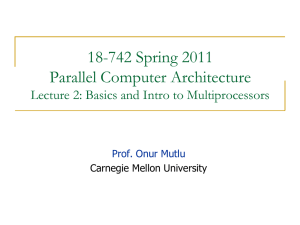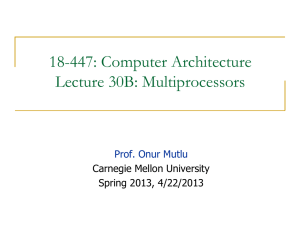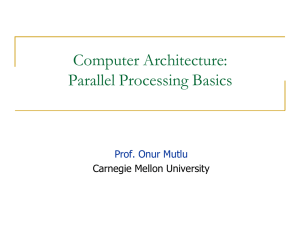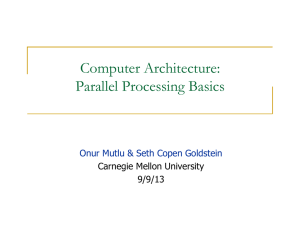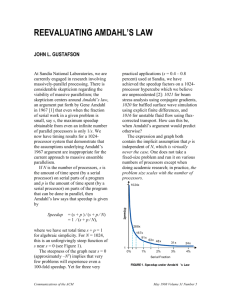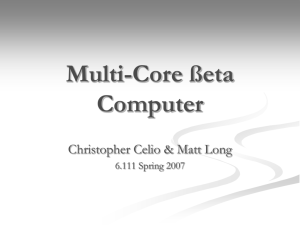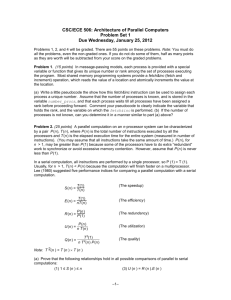18-742 Fall 2012 Parallel Computer Architecture Lecture 2: Basics
advertisement
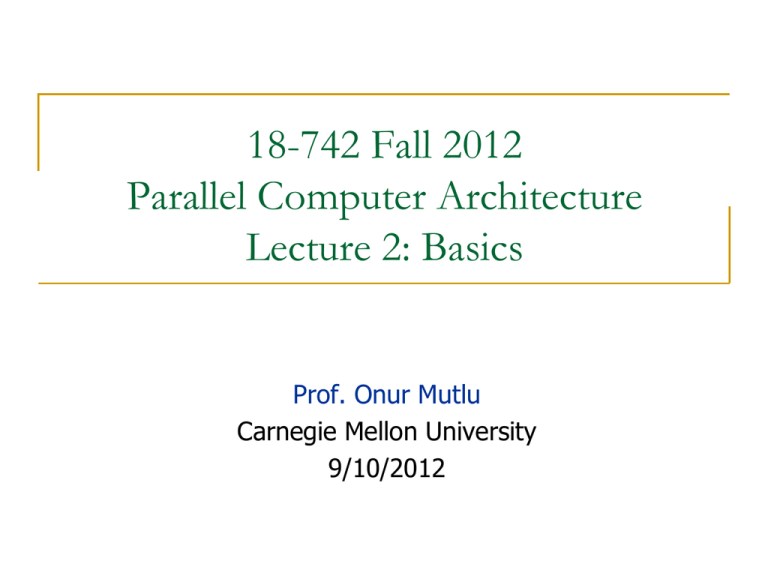
18-742 Fall 2012 Parallel Computer Architecture Lecture 2: Basics Prof. Onur Mutlu Carnegie Mellon University 9/10/2012 Reminder: Assignments for This Week 1. Review two papers from ISCA 2012 – due September 11, 11:59pm. 2. Attend NVIDIA talk on September 10 – write an online review of the talk; due September 11, 11:59pm. 3. Think hard about Literature survey topics Research project topics 4. Examine survey and project topics from Spring 2011 5. Find your literature survey and project partner 2 Reminder: Reviews for This Week Due: Tuesday September 11, 11:59pm Required – Enter reviews in the online system Pick two papers from ISCA 2012 proceedings At least one of them should be new to you Cannot be a paper you have co-authored http://isca2012.ittc.ku.edu/index.php?option=com_content&vi ew=article&id=53&Itemid=57 Read them thoroughly Write a “critical” review for each paper online Bonus: pick three papers instead of two 3 Reminder: NVIDIA Talk Today NVIDIA Tech Talk by ECE Alumnus, Philip Cuadra Monday, September 10, 2012 7-9 pm, HH-1107 Refreshments will be provided. Inside the Kepler GPU Architecture and Dynamic Parallelism This talk will dive into the features of the compute architecture for “Kepler” – NVIDIA’s new 7-billion transistor GPU. From the reorganized processing cores with new instructions and processing capabilities, to an improved memory system with faster atomic processing and lowoverhead ECC, we will explore how the Kepler GPU achieves world leading performance and efficiency, and how it enables wholly new types of parallel problems to be solved. The software improvements to expose the new dynamic parallelism features of the architecture will also be discussed. Your job: Attend the talk and write a review of the talk. 4 Reminder: How to Do the Reviews Brief summary is the problem the paper is trying to solve? are the key ideas of the paper? Key insights? is the key contribution to literature at the time it was written? are the most important things you take out from it? Strengths (most important ones) What What What What Does the paper solve the problem well? Weaknesses (most important ones) This is where you should think critically. Every paper/idea has a weakness. This does not mean the paper is necessarily bad. It means there is room for improvement and future research can accomplish this. Can you do (much) better? Present your thoughts/ideas. What have you learned/enjoyed most in the paper? Why? Review should be short and concise (~half a page or shorter) 5 Reminder: Advice on Paper/Talk Reviews When doing the reviews, be very critical Always think about better ways of solving the problem or related problems Do background reading Reviewing a paper/talk is the best way of learning about a research problem/topic Think about forming a literature survey topic or a research proposal 6 Reminder: Literature Survey More information to come Read a lot of papers; find focused problem areas to survey papers on 7 Supplementary Readings on Research, Writing, Reviews Hamming, “You and Your Research,” Bell Communications Research Colloquium Seminar, 7 March 1986. http://www.cs.virginia.edu/~robins/YouAndYourResearch.html Levin and Redell, “How (and how not) to write a good systems paper,” OSR 1983. Smith, “The Task of the Referee,” IEEE Computer 1990. Read this to get an idea of the publication process SP Jones, “How to Write a Great Research Paper” Fong, “How to Write a CS Research Paper: A Bibliography” 8 Quiz 0 (Student Info Sheet) Was due Sep 7 (this Friday) Our way of getting to know about you fast All grading predicated on passing Quiz 0 But, you are not in this room for grades anyway 9 Today’s Lecture Basics of Parallel Processing Outline of required readings (no reviews required yet): Hill, Jouppi, Sohi, “Multiprocessors and Multicomputers,” pp. 551-560 in Readings in Computer Architecture. Hill, Jouppi, Sohi, “Dataflow and Multithreading,” pp. 309-314 in Readings in Computer Architecture. Suleman et al., “Accelerating Critical Section Execution with Asymmetric Multi-Core Architectures,” ASPLOS 2009. Culler & Singh, Chapter 1 10 Parallel Computer Architecture: Basics 11 What is a Parallel Computer? Definition of a “parallel computer” not really precise “A ‘parallel computer’ is a “collection of processing elements that communicate and cooperate to solve large problems fast” Almasi and Gottlieb, “Highly Parallel Computing,” 1989 Is a superscalar processor a parallel computer? A processor that gives the illusion of executing a sequential ISA on a single thread at a time is a sequential machine Almost anything else is a parallel machine Examples of parallel machines: Multiple program counters (PCs) Multiple data being operated on simultaneously Some combination 12 Remember: Flynn’s Taxonomy of Computers Mike Flynn, “Very High-Speed Computing Systems,” Proc. of IEEE, 1966 SISD: Single instruction operates on single data element SIMD: Single instruction operates on multiple data elements MISD: Multiple instructions operate on single data element Array processor Vector processor Closest form: systolic array processor, streaming processor MIMD: Multiple instructions operate on multiple data elements (multiple instruction streams) Multiprocessor Multithreaded processor 13 Why Parallel Computers? Parallelism: Doing multiple things at a time Things: instructions, operations, tasks Main Goal Improve performance (Execution time or task throughput) Execution time of a program governed by Amdahl’s Law Other Goals Reduce power consumption Improve cost efficiency and scalability, reduce complexity (4N units at freq F/4) consume less power than (N units at freq F) Why? Harder to design a single unit that performs as well as N simpler units Improve dependability: Redundant execution in space 14 Types of Parallelism and How to Exploit Them Instruction Level Parallelism Data Parallelism Different instructions within a stream can be executed in parallel Pipelining, out-of-order execution, speculative execution, VLIW Dataflow Different pieces of data can be operated on in parallel SIMD: Vector processing, array processing Systolic arrays, streaming processors Task Level Parallelism Different “tasks/threads” can be executed in parallel Multithreading Multiprocessing (multi-core) 15 Task-Level Parallelism: Creating Tasks Partition a single problem into multiple related tasks (threads) Explicitly: Parallel programming Easy when tasks are natural in the problem Difficult when natural task boundaries are unclear Transparently/implicitly: Thread level speculation Web/database queries Partition a single thread speculatively Run many independent tasks (processes) together Easy when there are many processes Batch simulations, different users, cloud computing workloads Does not improve the performance of a single task 16 MIMD Processing Loosely coupled multiprocessors No shared global memory address space Multicomputer network Usually programmed via message passing Network-based multiprocessors Explicit calls (send, receive) for communication Tightly coupled multiprocessors Shared global memory address space Traditional multiprocessing: symmetric multiprocessing (SMP) Existing multi-core processors, multithreaded processors Programming model similar to uniprocessors (i.e., multitasking uniprocessor) except Operations on shared data require synchronization 17 Main Issues in Tightly-Coupled MP Shared memory synchronization Cache consistency More commonly called cache coherence Ordering of memory operations Locks, atomic operations What should the programmer expect the hardware to provide? Resource sharing, contention, partitioning Communication: Interconnection networks Load imbalance 18 Aside: Hardware-based Multithreading Coarse grained Fine grained Quantum based Event based (switch-on-event multithreading) Cycle by cycle Thornton, “CDC 6600: Design of a Computer,” 1970. Burton Smith, “A pipelined, shared resource MIMD computer,” ICPP 1978. Simultaneous Can dispatch instructions from multiple threads at the same time Good for improving execution unit utilization 19 Caveats of Parallelism Amdahl’s Law p: Parallelizable fraction of a program N: Number of processors 1 Speedup = 1-p + p N Amdahl, “Validity of the single processor approach to achieving large scale computing capabilities,” AFIPS 1967. Maximum speedup limited by serial portion: Serial bottleneck Parallel portion is usually not perfectly parallel Synchronization overhead (e.g., updates to shared data) Load imbalance overhead (imperfect parallelization) Resource sharing overhead (contention among N processors) 20 Parallel Speedup Example a4x4 + a3x3 + a2x2 + a1x + a0 Assume each operation 1 cycle, no communication cost, each op can be executed in a different processor How fast is this with a single processor? How fast is this with 3 processors? 21 22 23 Speedup with 3 Processors 24 Revisiting the Single-Processor Algorithm Horner, “A new method of solving numerical equations of all orders, by continuous approximation,” Philosophical Transactions of the Royal Society, 1819. 25 26 Superlinear Speedup Can speedup be greater than P with P processing elements? Happens in two ways: Unfair comparisons Memory/cache effects 27 Utilization, Redundancy, Efficiency Traditional metrics Utilization: How much processing capability is used U = (# Operations in parallel version) / (processors x Time) Redundancy: how much extra work is done with parallel processing Assume all P processors are tied up for parallel computation R = (# of operations in parallel version) / (# operations in best single processor algorithm version) Efficiency E = (Time with 1 processor) / (processors x Time with P processors) E = U/R 28 Utilization of Multiprocessor 29 30 Caveats of Parallelism (I) 31 Amdahl’s Law Amdahl, “Validity of the single processor approach to achieving large scale computing capabilities,” AFIPS 1967. 32 Amdahl’s Law Implication 1 33 Amdahl’s Law Implication 2 34 Caveats of Parallelism (Again) Amdahl’s Law f: Parallelizable fraction of a program N: Number of processors 1 Speedup = 1-f + f N Amdahl, “Validity of the single processor approach to achieving large scale computing capabilities,” AFIPS 1967. Maximum speedup limited by serial portion: Serial bottleneck Parallel portion is usually not perfectly parallel Synchronization overhead (e.g., updates to shared data) Load imbalance overhead (imperfect parallelization) Resource sharing overhead (contention among N processors) 35 Sequential Bottleneck N=10 N=100 1 0.96 0.92 0.88 0.84 0.8 0.76 0.72 0.68 0.64 0.6 0.56 0.52 0.48 0.44 0.4 0.36 0.32 0.28 0.24 0.2 0.16 0.12 0.08 0.04 N=1000 0 200 190 180 170 160 150 140 130 120 110 100 90 80 70 60 50 40 30 20 10 0 f (parallel fraction) 36 Why the Sequential Bottleneck? Parallel machines have the sequential bottleneck Main cause: Non-parallelizable operations on data (e.g. nonparallelizable loops) for ( i = 0 ; i < N; i++) A[i] = (A[i] + A[i-1]) / 2 Single thread prepares data and spawns parallel tasks (usually sequential) 37 Another Example of Sequential Bottleneck 38 Bottlenecks in Parallel Portion Synchronization: Operations manipulating shared data cannot be parallelized Locks, mutual exclusion, barrier synchronization Communication: Tasks may need values from each other - Causes thread serialization when shared data is contended Load Imbalance: Parallel tasks may have different lengths Due to imperfect parallelization or microarchitectural effects - Reduces speedup in parallel portion Resource Contention: Parallel tasks can share hardware resources, delaying each other Replicating all resources (e.g., memory) expensive - Additional latency not present when each task runs alone 39 Difficulty in Parallel Programming Little difficulty if parallelism is natural Difficulty is in “Embarrassingly parallel” applications Multimedia, physical simulation, graphics Large web servers, databases? Getting parallel programs to work correctly Optimizing performance in the presence of bottlenecks Much of parallel computer architecture is about Designing machines that overcome the sequential and parallel bottlenecks to achieve higher performance and efficiency Making programmer’s job easier in writing correct and highperformance parallel programs 40 Parallel and Serial Bottlenecks How do you alleviate some of the serial and parallel bottlenecks in a multi-core processor? We will return to this question in the next few lectures Reading list: Hill and Marty, “Amdahl’s Law in the Multi-Core Era,” IEEE Computer 2008. Annavaram et al., “Mitigating Amdahl’s Law Through EPI Throttling,” ISCA 2005. Suleman et al., “Accelerating Critical Section Execution with Asymmetric Multi-Core Architectures,” ASPLOS 2009. Joao et al., “Bottleneck Identification and Scheduling in Multithreaded Applications,” ASPLOS 2012. Ipek et al., “Core Fusion: Accommodating Software Diversity in Chip Multiprocessors,” ISCA 2007. 41 Bottlenecks in the Parallel Portion Amdahl’s Law does not consider these How do synchronization (e.g., critical sections), and load imbalance, resource contention affect parallel speedup? Can we develop an intuitive model (like Amdahl’s Law) to reason about these? Example papers: A research topic Eyerman and Eeckhout, “Modeling critical sections in Amdahl's law and its implications for multicore design,” ISCA 2010. Suleman et al., “Feedback-driven threading: power-efficient and high-performance execution of multi-threaded workloads on CMPs,” ASPLOS 2008. Need better analysis of critical sections in real programs 42 Reviews Due Sunday Sunday, September 16, 11:59pm. Suleman et al., “Accelerating Critical Section Execution with Asymmetric Multi-Core Architectures,” ASPLOS 2009. Suleman et al., “Data Marshaling for Multi-core Architectures,” ISCA 2010. Joao et al., “Bottleneck Identification and Scheduling in Multithreaded Applications,” ASPLOS 2012. 43
